Satellite images provide a true picture of earth and its environment in real-time. The large constellation of remote sensing satellites orbiting the earth provides a comprehensive and periodic coverage of the earth, enabling myriad uses for the benefit of mankind. From mapping the shrinking polar ice and glacial cover, to increasing desertification, from devastating floods to monitoring drought, whether its mapping the aftermath of destructive cyclones and earthquakes or the study of more gradual morphological changes in a city’s Urban Sprawl over time, satellite images have been providing a wealth of information to scientists, planners and decision makers in both government and private sector for effective policy and decision making.
(Image credit: NASA)
Brief History: The journey so far
Widespread use of satellite images began over 50 years ago when the two superpowers of the time, USA and USSR launching their CORONA and ZENIT-2 programs respectively. However, remote sensing got its real boost with the launch of Landsat-1 on July 23, 1972. Landsat 1, which was initially called ERTS (Earth Resources Technology Satellite), was the first satellite designed to study and to monitor the Earth’s surface. The Landsat series of satellites is currently in its 48th year of operation and has seen eight launches, with the latest Landsat 8 launched in orbit in 2013.
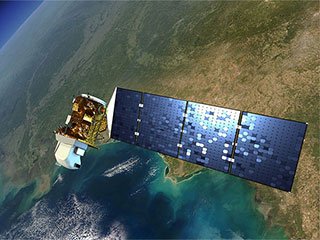
(Landsat 8; Image Credit: NASA)
Prior to 1960s, “Aerial Photography” was the main source of collecting information over a particular area using airplanes and balloons. The term "Remote sensing" began to be increasingly used when scientists started deriving information from both optical and non-optical sensors aboard the satellites which could cover much more land space than planes and monitor areas on a regular basis. This period also coincided with rapid developments in Computer technology which moved from large mainframe machines to small microcomputers. The availability of satellite images in “digital format” rather than analog provided information in graphic form instead of numerical output. There was also a vast improvement in the on-board sensors that recorded the Earth’s surface simultaneously in several different portions of the electro-magnetic spectrum. In the late 1960s and 1970s, the social movements awakened a new and continuing concern about the changes in the Earth’s physical environment. Remotely sensed imagery from satellites - analyzed and enhanced with computers - made it possible to detect and monitor these changes.
Current Scenario:
As of date, as many as 20 nations have launched over 80 earth observation satellite through their civilian space programs orbiting the earth with a wide range of sophisticated remote sensing payloads to monitor the Earth’s surface.
The first commercial high sub meter resolution satellite QuickBird was launched in Nov. 2000. Since then the market for high resolution satellite has grown by leaps and bounds and we have several private players in the intensively competitive high resolution satellite image market.
Some of the prominent names like GeoEye, Maxar (WorldView/QuickBird), Airbus (Pleiades), SIIS (Kompsat), Spot Image, BlackBridge (RapidEye), ImageSat International(Eros), PlanetLabs, China Siwei (SuperView-1, 2,3,4, TripleSat (DMC3 Constellation) have a vast constellation of satellites collecting high resolution satellite images on demand.
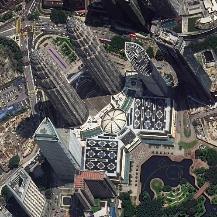
Image Credit: WorldView (30 cm.Res.)
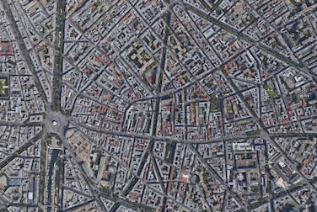
Image Credit: SPOT (6m resolution)
The table below lists around 22 high resolution satellite images with resolutions ranging from 0.30 m to 5m. Many of these satellites have stereo capability enabling the creation of photogrammetric DTM and 3D City models.
High Resolution
| Satellite | Resolution |
|---|---|
| WorldView-3/4 | 50-cm Pan, Natural Color, 4-band PS + 2-m MS |
| Pléiades 1 | 30-cm Pan, Natural Color, 4-band PS + 1.2-m MS |
| SuperView-1 | 50-cm Pan + 2-m 4-band MS |
| GeoEye-1 WorldView-1/2/3/4 QuickBird |
70-cm Pan, Natural Color, 4-band PS + 2.8-m MS |
| KOMPSAT-3A | 55-cm Pan, Natural Color, 4-band PS + 2.2-m MS |
| KOMPSAT-3 | 70-cm Natural Color, 4-band PS, Pan + 2.8-m MS |
| EROS A EROS B |
2-m Pan 70-cm Pan |
| SkySat | ≥ 72-cm Pan (raw) ≥ 1-m 4-band MS (raw) 80-cm Ortho Scene |
| Deimos-2 | 75-cm Natural Color and 4-band PS 1-m Pan + 4-m MS |
| IKONOS | 80-cm Pan + 3.2-m MS |
| GaoFen-1 | 2-m Pan + 8-m MS |
| GaoFen-2 | 80-cm Pan + 3.2-m MS |
| TripleSat | 80-cm Natural Color, 4-band PS, Pan + 3.2-m MS |
| TeLEOS-1 | 1-m Pan |
| IRS Cartosat 2 | 1-m Pan |
| SPOT 6/7 | 1.5-m Pan, Natural Color, 4-band PS + 6-m MS |
| FORMOSAT-5 | 2-m Pan or 4-m MS 2-m Pan + 4-m MS |
| ZiYuan-3 | 2.1-m Pan + 5.8-m MS |
| PlanetScope | 3-m 4-band MS |
| ZiYuan-3 | 3.5-m Pan 2.5-m Pan |
(Satellite image details credit: Derived from Apollo Imaging)
High Resolution Satellite Image Pricing
| Type of Satellite Imagery | Price in USD Archive - > 90 days | Price in USD for Priority Tasking |
|---|---|---|
| 0.3 -1.5 m Resolution Stereo High Resolution Satellite Imagery | USD 16 to USD 48 per km2 | USD 28 to USD 112 per km2 (minimum area of 100 km2) |
| Sub Meter Mono High Resolution Satellite Imagery | USD 4.50 to USD 24 per km2 | USD 28 to USD 56 per km2 (minimum area of 100 km2) |
| 1-3 m Resolution Mono High Resolution Satellite Imagery | USD 1.80 to USD 4.5 per km2 (minimum area of 100 -500 km2) |
USD 8.65 to USD 13.5 per km2 (minimum area of 100 -500 km2) |
(Pricing credit: Derived from Apollo Imaging)
Medium Resolution Satellite Images
The medium resolution satellite images on the other hand are available from resolutions ranging from 5m to 56m and cover a large swath of land enabling repetitive capture of earth’s surface for landcover, forestry and other environmental applications. Some of the best known satellites in this category are Landsat - currently in its 8th edition, French Satellite - SPOT Series, European Space Agency’s Sentinel series and Indian remote sensing satellites - IRS, Cartosat and Resourcesat.
The table below depicts some of the popular remote sensing satellites providing data in the 5m to 56 m spatial resolution category.
Medium and Low Resolution
| Satellite | Resolution |
|---|---|
| IRS LISS 4-MX (Resourcesat 1-2) | 5-m MS |
| RapidEye | 5-m 5-band MS |
| SPOT 6/7 | 6-m Natural Color 6-m 4-band MS |
| Sentinel-1 and 2 | 10-m MS |
| Deimos-1 | 22-m |
| IRS LISS III Resourcesat-2 | 24-m MS |
| Landsat 8 | 15-m Pan + 30-m MS |
| IRS AWiFS Resourcesat-2 | 56-m MS |
Some medium resolution satellite images: like Sentinel 1 and 2 at 10m, Landsat 8 at 15m pan and 30m MS are freely available to download allowing researchers and companies to access very good quality images for their chosen filed or project.
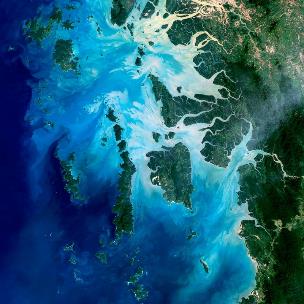
Mergui Archipelago, Myanmar, (Image Credit: Landsat)
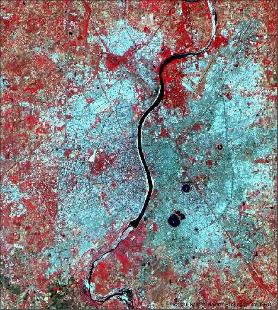
LISS-3 image of Ahmedabad (image credit: ISRO)
Applications of Satellite Imagery & Remote Sensing Data
Remote sensing data provides critical information that helps in monitoring various applications like image fusion, change detection and land cover classification. Remote sensing is a key technique used to obtain information related to the earth’s resources and environment. The availability of satellite images of high resolution satellite images along with features like “Street View” on various mapping applications like Google Earth and Bing Maps have really helped to popularize satellite imagery data.
Remotely sensed satellite images and data include spectral, spatial and temporal resolutions. Spectral resolution describes the ability of a sensor to define fine wavelength intervals and it involves elements of remotely sensed image classification. Spatial resolution defines the size of an object that can be seen clearly on an image and it’s one of the main aspect which influences the accuracy of ground object. Temporal resolution can be defined as the amount of time needed to revisit and acquire data for the exact same location and it helps in generation of land cover maps for urban planning, land use change detection and transportation and environmental planning.
Listed below are some of the main applications of satellite images for remote sensing
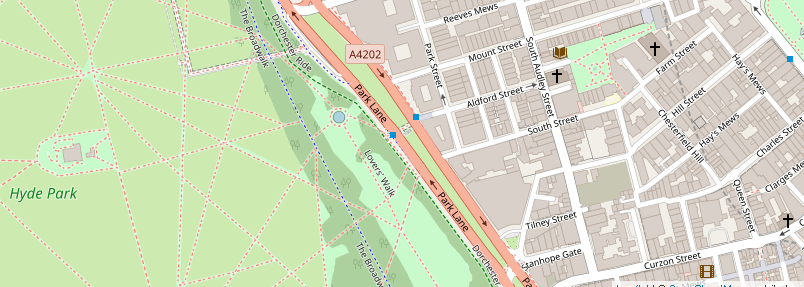
(Image Credit: Open Street map)
1. Providing a base map for reference
Highly detailed Ortho-imagery from high resolution satellite imagery provides a pictorial image of the area of interest along with its surrounding areas. These maps are geo-referenced and provide a wealth of details to give a complete picture an area. The base maps can be used for variety of purposes such as transportation planning, site selection for new railway/airports, urban planning, property tax surveys, mapping of urban zones like residential. Commercial and industrial etc.
2. Landuse/Landcover Mapping
Satellite images are probably one of the quickest and most economical ways of creating a landuse/landcover map of an area. The images provide a true picture of the current state of how the land is being used.
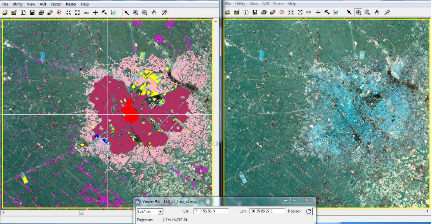
(Image Credit: AABSyS 5M clutter for Addis Ababa, Ethiopia)
A change detection study of the area with images of different vintage can reveal patterns of growth of a city’s urban sprawl, the increase/decrease in forest cover, extents of damages caused by flood or drought. With the wide range of commercially available remote sensing software, one can create highly accurate landuse maps of any region of the world sitting in the comfort of their office or home without any field visits. Landuse or Clutter Maps along with other layers like DTM, Vector (roads), population data are also used by telecom companies for their network planning purposes and are available at 20 to 50 M resolution for country/Regional data, 5 to 10M for Urban areas, and highly detailed 1 to 5m 2D and 3D maps for detailed LTE/5G planning.
3. 3D GIS and City Models
(Image Credit: AABSyS 3D data for Sydney)
High resolution stereo satellite imagery (0.30 m to 0.50 m) has come as a boon as it provides cost-effective stereo images over large areas in a quick time and has quickly over taken aerial photography which requires lot of special permissions and sophisticated equipment to acquire data.
3D city models are digital models of urban areas representing the terrain surface, buildings, vegetation, infrastructure and landscape elements of urban areas. These images provide vivid details which are helpful in creating two-dimensional and three-dimensional geo-referenced spatial data. 3D city models allow the presentation, exploration, analysis, and management of tasks in a large number of different application domains. This data is useful for urban/ rural planning departments, Site selection for next generation 5G network planning, Smart city application for Drainage, Sewerage, Water supply planning etc.
4. Applications in Mining
(Image Credit: WorldView-3 Satellite Map Kalgoorlie Mine, Australia)
Satellite images with sophisticated hyperspectral range are useful in the pre-feasibility and feasibility stages of the mineral exploration. Giving the “bigger picture” they also give important indications about the mineral potentiality of the area to be considered for mineral extraction. Satellite remote sensing based mapping and its integration in a GIS platform help geologists and mining companies to map the mineral potential zones easily and save precious time. The spectral analysis of satellite image bands helps scientists to identify and map mineral availability through special indicators, enabling them to narrow down their geo physical, geo chemical and test drilling activities to high potential zones.
5. Planning for disaster mitigation
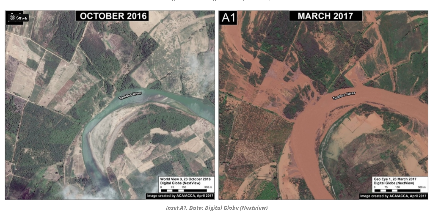
(Image Credit: Sentinel)
Satellite images with their capability to revisit the same areas multiple times are quite useful in assessment of damage caused by natural calamities such as floods, cyclones, earthquakes and landslides which become difficult to access in such times. Satellite images provide quick and accurate information of the disaster hit area and are quite useful in planning relief and rescue operations. They are also useful for site selection of storm/flood shelters. Pre and Post imagery as shown in the above image clearly show the extent of damage caused by the catastrophic flood event.
6. Applications in Agriculture and Forestry
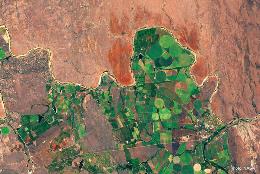
(Image Credit: NASA)
Satellite images are an important tool for managing the world’s agricultural resources which are critical to feed the ever increasing population across the world. The problems of deforestation and desertification are also affecting the availability of arable land. Many areas are also affected by salinization due to over irrigation and some rain dependent areas are always under the shadow of recurring draughts. Remote sensing and GIS can help provide solutions for increased agricultural production and proper management of farmlands by obtaining reliable data on not only the types, but also the quality, quantity and location of these resources. Remote sensing based studies can provide accurate information on acreage, monitoring of crop health and yield estimation.
(Image Credit: Landsat image of Sunderban, NASA)
Vast areas of forests are under threat due to forest fires, illegal felling of trees for agriculture, urban encroachment and infrastructure projects like dams and highways etc. Satellite imagery and GIS can be quite helpful tool in the improvement of the present systems of acquiring and generating maps and resource data for forestry mapping. This information collected is necessary for the implementation of effective management decisions for this critical resource. The pink areas in the upper part of the image shows the clearing of mangrove forests in the Sunderban Delta for agriculture, threatening the fragile mangrove ecosystem.
7. Monitoring Climate Change
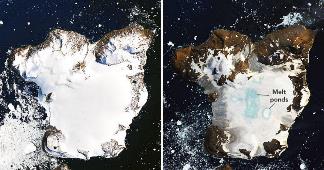
(Image Credit: NASA)
Satellite images being the “eye in the sky” provide valuable visual evidence in monitoring the polar ice caps. These images are an irrefutable evidence of the dramatic changes happening in the Polar Regions or the retreat of several glaciers across the world due to rising temperatures. Similarly, satellite images also show the advance of deserts in to newer areas and the massive deforestation and forest fire incidents all across the world which often compel the government and environmental agencies to take necessary action.
The applications and benefits of satellite images are immense. They have proven to be a reliable and cost effective source of collecting valuable data for scientists, planners and decision makers to monitor the earth for the larger collective benefit of mankind.
About the Author
Dr. Prasun Ranjan is part of AABSyS Business Development team. He is an expert in remote sensing and has rich experience in handling satellite image processing projects.




Add your comment